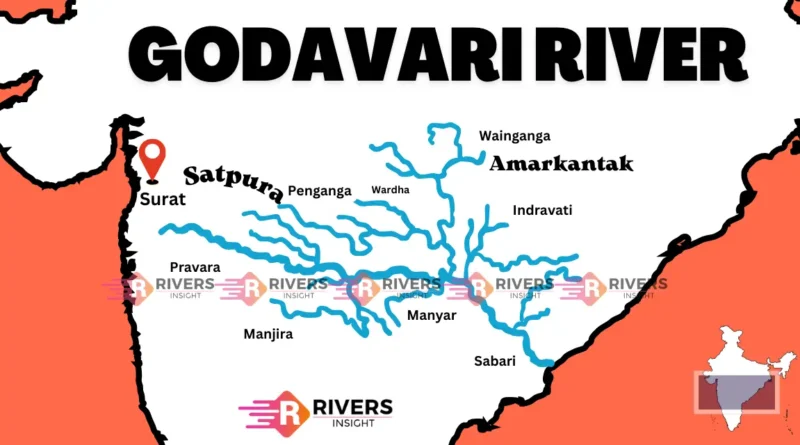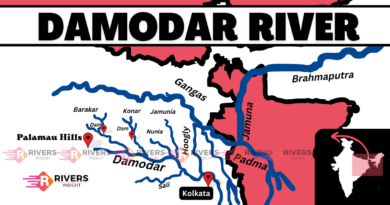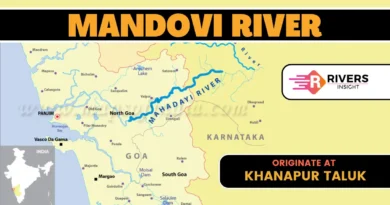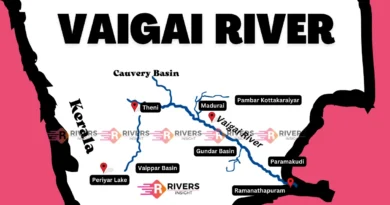Godavari River: Origin, Tributaries, Map, Length, & Dams
Godavari River is also known as the ‘Dakshina Ganga or Vridha Ganga,’ and originates from the Brahmagiri Hill near Trimbakeshwar in Maharashtra, winding its way through Maharashtra, Telangana, Andhra Pradesh, and Odisha.
With a length of 1,465 kilometers, it’s India’s second-longest river after the Ganges. Its basin spans approximately 312,812 square kilometers, supporting various ecosystems from hills to plains.
| Known as | Dakshin Ganga |
| Length | 1465 km |
| Origin | Maharashtra |
| Largest Tributary | Pranhita River |
| Longest Tributary | Indravati River |
| Major Cities | Nashik, Nanded, Rajahmundry, Bhadrachalam |
| Area | ~3 lakh sq. km |
| End point | Bay of Bengal |
Table of Contents
Godavari River System
Origin and Course of Godavari River
The Godavari River starts from the Brahmagiri Hill in Maharashtra, India. From there, it flows through the following states:
- Maharashtra
- Telangana
- Andhra Pradesh
- Odisha
In Maharashtra, it passes through places like Nashik and Nanded. Then, it goes through Telangana, touching districts such as Karimnagar and Warangal. The river gets bigger as it joins with other rivers like Pranahita.
Moving into Andhra Pradesh, it forms the Dowleswaram Barrage near Rajahmundry. This barrage helps control the river’s flow and stops saltwater from coming in.
Finally, the Godavari River merges with the Sabari River in Odisha before reaching the Bay of Bengal. This journey shows how the river travels through different states, providing water and life.
Map of the Godavari River System
The image below shows the complete Godavari River with its tributaries, providing a comprehensive view of the river system. This map illustrates the course of the Godavari River, how it flows through various regions and its passage through different states in India.
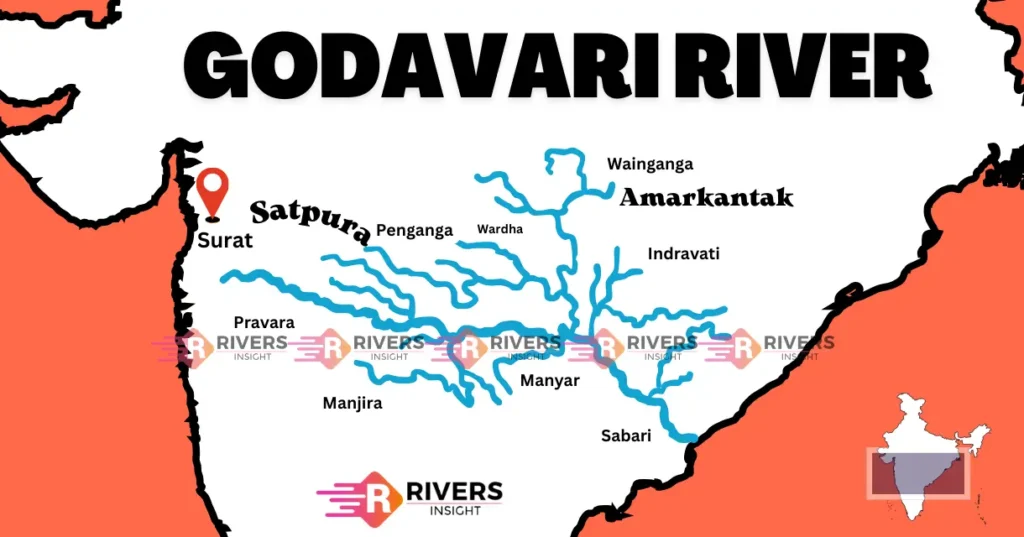
Area Distribution of Godavari Basin
The Godavari River basin covers several states, each adding to its large area. Here’s a brief overview of how the states share this basin:
- Maharashtra: Nearly half of the basin’s area, around 48.6%.
- Andhra Pradesh: Approximately 23.4%.
- Madhya Pradesh: About 10.0%.
- Chhattisgarh: Around 10.9%.
- Odisha: Approximately 5.7%.
Geographical Boundaries
Geographical Boundaries of the Godavari River Basin are as follows:
- North: Satmala Hills, Ajanta range, Mahadeo Hills.
- South and East: Eastern Ghats.
- West: Western Ghats.
Settlements Along the Godavari River
- Nashik: Located in Maharashtra, Nashik is known for its temples and is a major pilgrimage destination.
- Nanded: Situated in Maharashtra, Nanded is home to the Takht Sachkhand Sri Hazur Abchalnagar Sahib, a prominent Sikh pilgrimage site.
- Rajahmundry: Found in Andhra Pradesh, Rajahmundry is a cultural hub known for its historic bridges and temples.
- Bhadrachalam: In Telangana, Bhadrachalam is famous for the Sri Sita Ramachandra Swamy Temple dedicated to Lord Rama.
- Kovvur: Located in Andhra Pradesh, Kovvur is known for its scenic beauty and is a major transportation hub.
- Rajamahendravaram (Rajahmundry): Also situated in Andhra Pradesh, Rajamahendravaram is known for its rich history and cultural heritage, with landmarks like the Godavari Bridge.
Divine Pilgrimage Sites
The Godavari River holds profound religious and pilgrimage significance, drawing devotees from across the country. In Hindu mythology, it is revered as a sacred river, with its banks adorned by temples, ghats, and holy sites. Pilgrimage along the Godavari is not just a journey but a spiritual odyssey, enabling devotees to forge a deep connection with the divine and seek blessings.
Here are some prominent pilgrimage sites along the River basin:
- Trimbakeshwar Temple, Maharashtra: Dedicated to Lord Shiva, this revered temple houses one of the twelve Jyotirlingas, attracting devotees seeking spiritual solace.
- Bhadrachalam, Telangana: Home to the Sri Sita Ramachandra Swamy Temple, where it’s believed Lord Rama stayed during his exile, inviting devotees to experience divine tranquility.
- Basar Saraswathi Temple, Telangana: Devotees flock to this sacred temple dedicated to Goddess Saraswathi, the embodiment of knowledge and wisdom, seeking her blessings.
- Rajahmundry, Andhra Pradesh: The Kotilingeswara Temple and Markandeya Temple here stand as architectural marvels, offering spiritual rejuvenation to visitors.
- Triveni Sangam, Rajahmundry, Andhra Pradesh: Witness the divine union of the Godavari and Krishna rivers, a sacred site for rituals and prayers, evoking a sense of spiritual reverence.
Godavari Pushkaram
Godavari Pushkaram is a significant Hindu festival celebrated every 12 years along the Godavari’s banks. During this 12-day festival, devotees take a holy dip in the river to cleanse their souls and seek divine blessings. The festival is believed to be a time when celestial energies align with the river, making it highly auspicious.
Besides ritual bathing, the festival encompasses religious ceremonies, processions, cultural performances, and spiritual discourses. It fosters unity, community harmony, and cultural exchange, attracting millions of devotees and stimulating local economies and tourism. Godavari Pushkaram is a cherished event, allowing people to commune with the divine and honor the sanctity of the Godavari River.
Tributaries of Godavari River
The Godavari River is nourished by several tributaries like the Pranahita, Sabari, and Indravati, each contributing significantly to the basin’s flow. Detailed assessments of these tributaries can be found in reports from the Central Water Commission.
➤ What is the largest tributary of the Godavari?
The Pranhita River is the largest tributary of the Godavari, contributing nearly 35% of the total basin area. It forms from the confluence of the Wardha and Wainganga rivers.
➤ Which is the longest tributary of the Godavari?
The Indravati River is considered the longest among the left-bank tributaries, known for its significant flow and role in the Godavari basin.
Left Bank Tributaries
Right Bank Tributaries
- Pravara
- Mula
- Manjra
- Peddavagu
- Maner
Dams of Godavari River
The Godavari Barrage, Polavaram Dam, and Sriram Sagar Dam are some of the critical infrastructure along the river. These projects are overseen by the Ministry of Jal Shakti for managing water resources and flood control.
Some major dams along the Godavari River are vital for regional development and environmental management:
| Dam | State |
|---|---|
| Godavari Barrage Dam | Andhra Pradesh |
| Sriram Sagar Dam | Telangana |
| Polavaram Dam | Andhra Pradesh |
| Upper Indravati Dam | Odisha |
| Upper Wardha Dam | Maharashtra |
| Dowleswaram Barrage | Andhra Pradesh |
| Gangapur Dam | Maharashtra |
| Jayakwadi Dam | Maharashtra |
In this article, we’ve covered everything about the Godavari River system, from its map and dams to its tributaries and features. If you have any questions or need more information, just ask in the comment box below. Your feedback and queries are highly appreciated!
Q1: Where does the Godavari River start and end?
A: It starts in Maharashtra’s Brahmagiri Hills and ends in the Bay of Bengal, near Antarvedi in Andhra Pradesh.
Q2: Which is the longest tributary of Godavari?
A: The Indravati River is considered the longest major tributary.
Q3: What is the total length of the Godavari River?
A: 1,465 kilometers (910 miles), making it India’s second-longest river.
Q4: What states does the Godavari River flow through?
A: Maharashtra, Telangana, Andhra Pradesh, Chhattisgarh, and Odisha.
Q5: What are the main tributaries of the Godavari River?
A: Major tributaries include Pranhita, Indravati, Sabari, Manjira, and Pravara.
More related articles:

